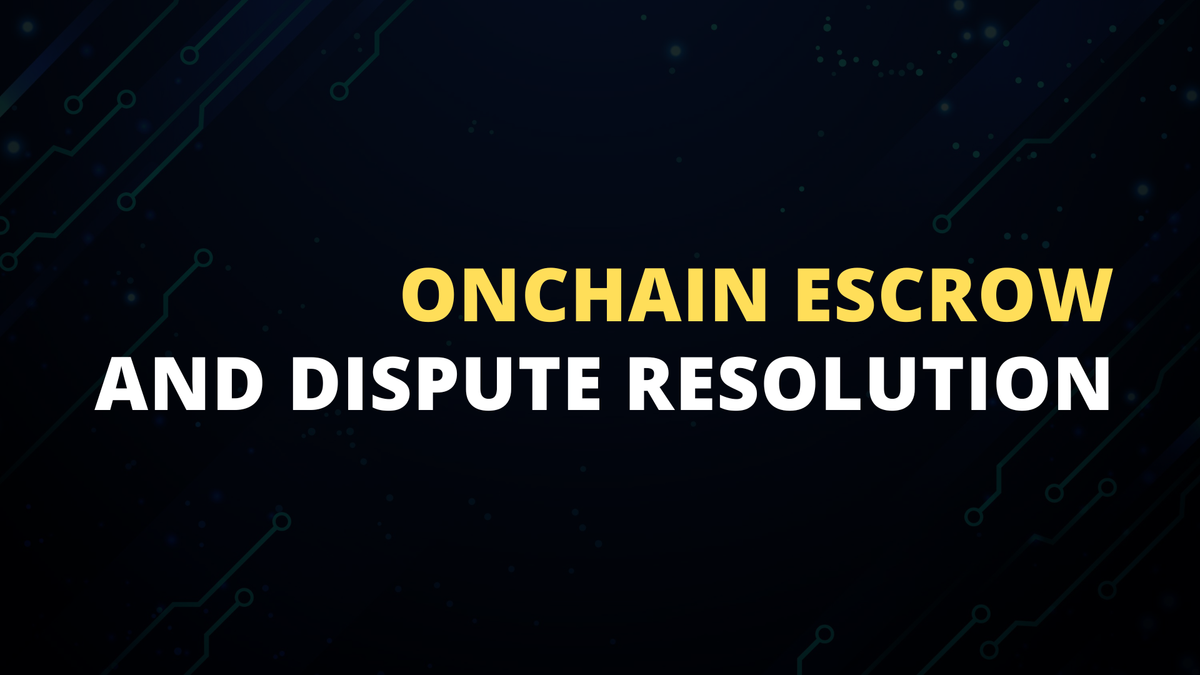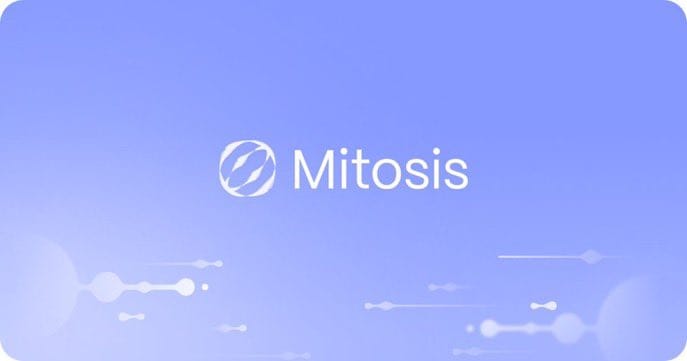Onchain Escrow and Dispute Resolution

Can smart contracts replace judges?
Onchain escrow and dispute resolution aim to eliminate middlemen by combining smart-contract automation with decentralized arbitration. In theory, this enables trustless transactions without centralized oversight. But in practice, most teams still rely on custodians and manual chargebacks, raising the question: Why hasn't Web3 solved disputes yet?
Why It’s Scarce
- Fragmented tooling
• Most DeFi projects focus on lending, trading, and yield strategies, not on escrow or arbitration.
• Building a fully trustless arbitration layer requires integrating off-chain jurors, on-chain event listeners, and variable lock-up logic. - Usability hurdles
• DAOs and power users have started exploring on-chain courts (Kleros, Aragon), but mainstream apps shy away from complexity.
• Non-tech users struggle to specify refund addresses, set lock-up periods, or interact with governance tokens. - Regulatory uncertainty
• How do on-chain rulings map to real-world courts?
• Enforcement outside the smart contract (e.g., reputational bonds, national arbitration treaties) remains an open question.
Smart Contract Escrow 101
At its core, an on-chain escrow contract holds funds until predefined conditions are met or a dispute is resolved. A minimal flow:
- Lock funds
- Payer calls
deposit()on an Escrow contract, sending ETH or ERC-20 tokens. - The contract records
payer,payee,amount, and optionalrefundAddress.
- Payer calls
- Release or refund
- If
payeedelivers, they callrelease(), transferring funds. - If there’s a disagreement, the
payerorpayeeescalates to arbitration.
- If
- Arbitration hook
- The Escrow contract implements the ERC-792 Arbitrable interface to request an on-chain arbitrator.
- Funds remain locked until the arbitrator’s ruling either forwards to
payeeor refunds topayer.
By embedding arbitration callbacks, escrow becomes non-custodial: no single party can abscond with funds.
Onchain Arbitration Tools
Kleros
- What it is: A decentralized court protocol where jurors stake PNK tokens and vote on evidence to resolve disputes.
- Integration:
- Build an Arbitrable contract per the ERC-792 standard.
- Specify the Kleros Court address and extra data (subcourt ID, vote count).
- Call
arbitrationRequest(); jurors are drawn randomly and stake tokens to vote.
- Incentives: Jurors who vote with the majority earn fees; minority voters get slashed, aligning juror behavior with honest rulings.
Aragon Court
- What it is: A DAO-native dispute resolution system that uses token-weighted “guardians” to rule by a plurality mechanism.
- Mechanics:
- Guardians lock ANT tokens to become eligible for cases.
- Commit-reveal voting and iterative appeals discourage cartels.
- Guardians who vote against the plurality pay a penalty; those aligned earn fees.
Circle’s Refund Protocol
- Purpose: Introduce on-chain escrow and chargeback‐style arbitration for ERC-20 stablecoin payments (e.g., USDC).
- Workflow:
- pay(to, amount, refundTo) locks funds in the Refund Protocol contract.
- The
recipientmay callrefundByRecipient(). - If disputed, a pre-designated
arbiterusesrefundByArbiter()they can only approve or deny; they cannot redirect funds elsewhere. - After the lock-up period,
withdraw()releases undisputed funds.
- Early withdrawal: Off-chain signed fee agreements allow partial releases before the lock-up ends.
- Learn more:
- Official blog: “Refund Protocol: Non-Custodial Dispute Resolution for Stablecoin Payments”
- Crypto news: “Circle Unveils Refund Protocol for Onchain USDC Disputes”
SmarTrust + Reactive Network
- Objective: Multichain escrow for freelancers and clients, with optional third-party adjudication.
- Architecture:
- Deploy escrow factories on multiple EVM chains.
- Emit
DisputeRaised/DisputeResolvedevents. - Reactive Smart Contracts (RSCs) listen → fetch → relay to a central adjudicator marketplace on Ethereum.
- Why it matters: Separates funds on any chain while coordinating disputes and juror assignment from one hub, a blueprint for truly cross-chain arbitration.
Real-World Use Cases
1. Freelance Disputes
Imagine Alice (Argentina) hires Bob (Peru) for a website redesign. They agree:
- Price: 1,000 USDC
- Delivery deadline: 30 days
- Dispute resolution: Kleros
Flow:
- Alice calls
Escrow.deposit(), locking 1,000 USDC. - Bob delivers, but Alice claims the design misses key features.
- Alice escalates:
Escrow.requestArbitration(). - Kleros jurors review GitHub commits, wireframes, and client feedback.
- The majority rules in Alice’s favor → funds refunded.
Platforms like SmarTrust automate this end-to-end, no Web3 magic needed by either party.
For a hands-on code example, see the StackOverflow discussion on “Dispute resolution in smart contracts,” where a basic escrow flow is outlined without breaking immutability principles.
2. Peer-to-Peer Lending
Bob lends Alice 5 ETH at 5% APR for 90 days. To secure repayment, they use an on-chain escrow + Kleros clause:
- Alice locks 5 ETH plus 0.25 ETH interest in
LoanEscrow.deposit(). - After 90 days:
- If Alice repays on time,
Escrow.release()sends 5.25 ETH to Bob. - If she defaults or a contest arises (e.g., network outage), either party calls
Escrow.requestArbitration().
- If Alice repays on time,
- Jurors assess the loan agreement, gas logs, and off-chain proof.
- Ruling triggers
refundByArbiter()orrelease()accordingly.
This model blends collateralization with genuine dispute handling—ideal for informal credit markets in emerging economies.
Challenges and Considerations
- Gas costs: Escrow + arbitration ≈ 5–10× the gas of a simple transfer.
- Refund address management: Custodial wallets and onramps may not let users pass
refundTo. - Juror quality: Ensuring jurors understand specialized domains (legal, creative, financial).
- Yield on locked funds: Idle escrow funds could be swept into DeFi (e.g., Aave) and shared between parties and arbiters.
- Enforcement off-chain: When on-chain rulings clash with national laws, parties rely on reputation, contractual bonds, or the New York Convention for arbitral awards.
Future Directions
- Interoperable arbitration networks: Schemes like Jur or future Ethereum Improvement Proposals could standardize arbitrator interfaces across chains.
- AI-assisted juror tools: Automated evidence summarization, anomaly detection, and bias analysis will speed up rulings and improve consistency.
- DAO governance integration: Disputes escalate from smart contracts into DAO votes, resolving complex, subjective cases with community stakes.
- Regulatory alignment: Clearer frameworks for recognizing on-chain rulings as binding will drive enterprise adoption.
Conclusion
Onchain escrow and dispute resolution remain niche but crucial components of a trustless economy. By leveraging smart contracts and decentralized arbitrators, whether Kleros’ jurors staking PNK, Aragon Court’s token-weighted guardians, Circle’s Refund Protocol, or Reactive-powered multichain escrow, developers can embed robust, non-custodial dispute flows in their dApps. Real-world pilots in freelance marketplaces and peer lending highlight the practical potential. As tooling, usability, and regulatory clarity improve, we’ll see on-chain conflict resolution shift from “nice-to-have” to a foundational feature across DeFi and beyond.
References
- Kleros Smart-Contract Integration Guide:
https://docs.kleros.io/integrations/types-of-integrations/1.-dispute-resolution-integration-plan/smart-contract-integration - Kleros Whitepaper (game-theoretic arbitration architecture):
https://kleros.io/whitepaper_long_en.pdf - Aragon Court Fundamentals:
https://legacy-docs.aragon.org/products/aragon-court/aragon-court - Circle Refund Protocol: Non-Custodial Dispute Resolution for Stablecoin Payments:
https://www.circle.com/blog/refund-protocol-non-custodial-dispute-resolution-for-stablecoin-payments - Reactive x SmarTrust: Building a Multichain Escrow Layer for Freelancers and Clients:
https://blog.reactive.network/reactive-x-smartrust-building-a-multichain-escrow-layer-for-freelancers-and-clients/ - Dispute Resolution Mechanism for Smart Contracts (Maastricht University)
https://cris.maastrichtuniversity.nl/en/publications/dispute-resolution-mechanism-for-smart-contracts
MITOSIS official links:
GLOSSARY
Mitosis University
WEBSITE
X (Formerly Twitter)
DISCORD
DOCS


Comments ()